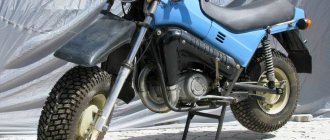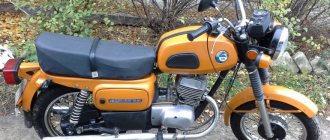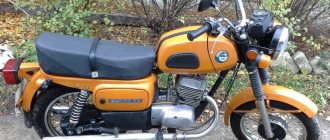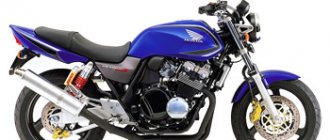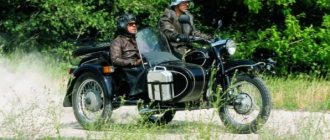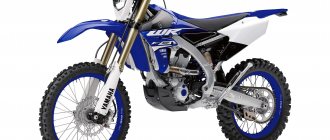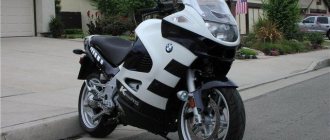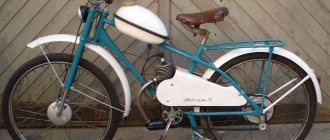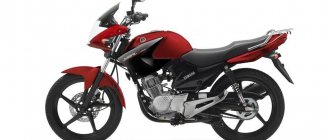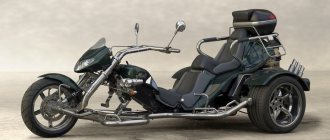History of creation
The history of creation dates back to 1984, when the first 200 motorcycles rolled off the assembly line of the Tula Machine Plant named after Ryabikov and went on sale. The peak of production occurred in 1986-1988. Tula was the pioneer of Soviet SUVs with forced air cooling, as well as the first bike in the USSR to have an electric starter.
Since the plant did not have a license to produce motorcycles, it was necessary to get out of the situation by installing small scooter wheels, which transferred Tula to the category of motor vehicles. The motorcycle owes its design to a group of artists from the Leningrad branch of VNIITE, led by S. Nikolaev.
An average of 11,000 motorcycles were produced per year for 12 years. They appealed to different categories of motorcyclists, but they were especially popular among villagers who went out to hunt and fish with them. It was also quite suitable for long trips.
In the early 90s, the quality of products began to suffer, and after 1993, the production of motorcycles sharply decreased. In 1996, their production was curtailed.
Features of purchasing motorcycle parts at Moto Life Market
If a rarity originally from the Soviet Union needs repair, then replacing original parts with Chinese analogues is not always possible; you need spare parts from the USSR. Parts for Ant and Tula scooters are presented in a wide range in the USSR Motorcycle Parts store. We only have high-quality components made to strict requirements from trusted manufacturers. We know all the intricacies of repairing Soviet motorcycles, so you can safely contact our managers for advice - they will advise the best option and send spare parts within the agreed time frame.
Specifications
| Motorcycle brand Tula | TMZ-5.951 | TMZ-5.952 |
| Engine | two-stroke, forced cooling, 200 cc. cm | two-stroke, forced cooling, 200 cc. cm |
| Power (hp) | 12,5 | 13 |
| Petrol | A 76 | A 76 |
| Fuel capacity/reserve (l) | 11/0,5 | 11/0,5 |
| Speed (km/h) | 90 | 85 |
| Weight (kg) | 129 | 126 |
| Rated voltage (volts) | 12 | 12 |
| Wheel travel front/rear. | 130mm/80mm | 130mm/80mm |
| Transmission | four-speed | four-speed |
| Brake Diameter(mm) | 150 | 150 |
| Fuel (consumption per 100 km/l) | 3,6 | 3,6 |
Watch a video review of the Tula TMZ-5.951 motorcycle produced in 19888:
TMZ-5.971
By the beginning of the 80s, the demand for motor scooters in the USSR had fallen significantly, which led, for example, to the cessation of production of Vyatka motor scooters in Vyatskie Polyany. Another manufacturer of scooters, the Tula Machine-Building Plant named after Ryabikov, did not want to leave the motorcycle market. Despite the presence of a powerful production of defense products, which allowed the plant to stay afloat even if the production of motorcycles was completely stopped, the managers and designers of the enterprise decided to continue producing motorcycles. We only decided to develop a type of two-wheeled and three-wheeled vehicle that is more in demand on the market.
In the 80s, Japanese companies expanded the range of two-wheeled, three-wheeled (trikes) and four-wheeled (quad bikes) off-road motorcycles on wide-profile tires with developed lugs. Tula designers decided to follow the same path, being the first in the USSR to create motorized transport for complete off-road use, knowingly expecting that it would be in high demand in rural areas and remote areas of the country.
The first result was the TMZ-5.951 two-wheeled motorcycle that appeared in 1985 on powerful, pot-bellied 6.70-10 tires that exerted low specific pressure on the ground. The 200 cc scooter engine with a forced air cooling fan was specially for this model, for the first time in the Soviet motorcycle industry, supplemented with a petal valve at the inlet, which significantly increased the traction characteristics of the engine. After eliminating the inevitable shortcomings for the first releases of a new model, the modernized motorcycle of 1989 received the TMZ-5.952 index.
The next step was the development of the first Soviet off-road trike TMZ-5.971, which hit the production line in 1991. The front part of the frame, front fork and engine remained the same as the TMZ-5.952. When designing the independent rear suspension, fundamentally the same scheme was used as that of the Ant cargo scooters, only the spatial tubular frame with stamped elements was noticeably strengthened, the dimensions of the rear suspension units were increased - the tricycle had to work in much more difficult conditions than a cargo scooter . In general, the designers of the Tula plant benefited from the experience of designing unified two-wheeled and three-wheeled vehicles, accumulated during the years of production of regular and cargo scooters.
The two-wheeled SUV also featured plastic cladding panels that were advanced for the 1980s and a front fender. Previously, on Soviet motorcycles, these parts were stamped from metal. The same noticeable plastic elements remain on the three-wheeled motorcycle. The motorcyclist and his passenger sat behind each other on a regular one-piece saddle, and large luggage racks were located above the right and left rear wheels, convenient, for example, for transporting bags of potatoes or boxes of apples. Without a passenger, the trike carried up to 120 kg of cargo, and with a passenger - approximately 90 kg. Soon, to increase the versatility of the vehicle, a TMZ-9.601 trailer was developed specifically for it, which could carry another 100 kg. Also in the 90s, a special module TMZ-9.906 appeared, which allows the owner or service company to turn a two-wheeled TMZ motorcycle into a three-wheeled one.
Technical specifications
| Number of places | 2 |
| dimensions | 2300x1350x1250 mm |
| Load capacity | 230 kg (including driver weight) |
| Engine | Gasoline, carburetor, single-cylinder, two-stroke |
| Working volume | 199 cm3 |
| Power | 13.6 hp at 5000 rpm |
| Weight | 250 kg |
| Maximum speed | 70 km/h |
| Fuel consumption | 5.5 l/100 km |
Advantages and disadvantages
The advantages of Tula motorcycles, which still attract potential buyers, include:
- simplicity and ease of maintenance;
- increased cross-country ability;
- reliability in operation;
- relatively low cost;
- low fuel consumption.
Among the shortcomings are the following:
- The wiring is not located very well, as a result of which moisture, dust and dirt often penetrate into it.
- not equipped with a fairing;
- quite massive, which can be critical on a bad road;
- does not develop very high speed;
- poor stability of the bike in inclement weather and a tendency to “cut” when making turns, which is due to wide tires.
Modifications
Over the entire period, the Tula motorcycle has been modified three times:
- TMZ-5.951. The model was produced for 6 years, starting in 1984. It weighed 129 kg. It could reach a speed of no more than 85 kilometers per hour. The engine had a power of 12.5 horsepower.
- TMZ-5.952. Also produced for 6 years, since 1990. Equipping with a lighter frame made it possible to reduce the total weight by 3 kg. The engine has become more powerful, although only half the horsepower has increased. Speed performance increased - now it was possible to accelerate to 90 kilometers per hour.
- TM3-5.971. It began to be produced at the same time as the previous model and was actually its redesigned modification with the TMZ-9.906 cargo module. The frame has been strengthened. However, neither the engine nor the steering wheel with the front fork have undergone any changes. The model was a three-wheeled motorcycle with a trunk weighing 129 kg (without a passenger). It was also provided for attaching a trailer for 1 quintal of cargo. The connecting nodes were hidden under a plastic lining.
Tricycle Tula 5.971
MY MOTORCYCLE
Has anyone seen such a device? I definitely didn't see it. That's why the photo from the magazine is unclear. So what is this miracle of motorcycle technology?
At the end of 1992, the team expanded the range of its motorcycle products with a new product: the 3-wheeled motorcycle TM3-5.97I. What vital requirements formed the basis for the design of a new vehicle for Russia and what category of buyers were they targeting this new model? The development of farms, dacha and individual construction, and simply living conditions in rural areas has given rise to an entire army of compatriots, whom the spring-autumn thaw cuts off from civilization and makes any type of activity difficult. These were the main reasons that prompted the plant to create a vehicle capable of delivering passengers and small consignments to places that are difficult to reach by conventional transport. Everyone liked the Ant, but the cross-country ability was not very good. And “Tula”, having enviable “all-terrain capability”, could not transport large loads. Therefore, the development of the design of the TMZ-5.971 tricycle was based on the use of well-proven components of both models. That is, they combined two in one - a good solution, in my opinion. The forced-cooled engine with a reed valve at the inlet remains unchanged, meaning it is completely interchangeable. After extensive serious testing, the motorcycle frame was strengthened, because the loads on it increased significantly. But at the same time, it is also completely unified in connection dimensions with the motorcycle one. The front fork and steering have also remained unchanged. In general, we can say that a similar part TMZ-5.952 was used as the front part of the tricycle, to which the TMZ-9.906 cargo module is attached at the points of attachment of the pendulum and shock absorbers (see photo).
The module frame is a spatial structure made of pipes and stamped steel parts, onto which the components of a cargo scooter are attached - a differential and balancers, hidden under a lining made of ABS plastic. Due to the difference in the designs of a motorcycle and a scooter, it turned out that the track of the rear wheels is asymmetrical relative to the longitudinal axis of the tricycle. Visually, this is noticeable by the different widths of the luggage areas on the right and left. Tests have shown that this is not noticeable in operation.
Loading capacity of the trunk is up to 120 kg (without a passenger) and 90 kg with a passenger.
A coupling device for towing a trailer is mounted on the differential box of the rear axle. Due to the trailer, the mass of payload that the motorized train can transport increases by 100 kg. The plant has already produced a trailer
TMZ-9.601, intended for use not only with a tricycle, but also with other motorcycles with an engine capacity of 200 cm3 or more. By the way, owners of the Tula-952 and 951-x motorcycles had the opportunity to convert them into a tricycle. but for this they needed, firstly, to buy a TMZ-9.906 cargo module, and secondly, without any modifications, in accordance with the instructions, attach it to the motorcycle. It took no more than two hours.
To be honest, I don’t know and haven’t found the further history of this transport, so I’ll end on this note for now......
TECHNICAL CHARACTERISTICS OF TRICYCLE TM3-5.97I. (brackets - with trailer TM3-9.606) Engine: single-cylinder, two-stroke with gas distribution by piston and valve not inlet; cylinder working volume, cm/cc - 199, diameter X "piston stroke, mm - 62X66, compression ratio (geometric) - 9.5, maximum power, kW (hp)/rpm - 10.00 {13 ,6)/5000, maximum torque, m.n. (kgf-m)/rpm - 16.5 (t.66)/4900; engine lubrication - together with fuel, oil content, % - 3; engine cooling system: forced, air, fan; power consumed by the fan, kW (PS) - 0.736 (1).
Power transmission: clutch - damper, multi-disc in an oil bath; gearbox: two-way, gear, 4-speed; transmission from the crankshaft to the clutch - chain, chain - PV-9.525-1300 TU-3-6-79; transmission from the gearbox to the main gear - chain, chain - PR-12.7-1820-2 GOST 13568-75; differential with bevel gears and two satellites; transmission from the gearbox to the rear wheels is by axle shafts with rubber-metal hinges.
Chassis: frame—stamped welded; front fork - telescopic with hydraulic shock absorbers, front wheel axial travel, mm - 155; rear wheel suspension - independent, spring with hydraulic shock absorbers; brakes: shoe type with manual drive on the front wheels and foot drive on the rear wheels; collapsible disc wheels; tire size, mm (inch) - 170-254 (6.70-10).
General data: turning radius, m, no more - 3; number of people transported - 2; load capacity taking into account the driver’s weight, kg - 230 (330); maximum speed, km/h - 70 (40); acceleration time on a section of 400 m, s - 36 (42); run-out from a steady speed of 50 km/h, m - 200; control fuel level, l/100 km, no more - 5.5 (6.1); minimum fuel consumption, l/)00 km - 5.2 (5.5); fuel consumption in the urban cycle, p/100 nm - 6.0 (6.5); braking distance, m, no more: from a speed of 40 km/h -~- 11 (15), from a speed of 60 km/h - 21; established service life before major overhaul, subject to compliance with the rules of operation and maintenance specified in the instructions, km, not less than - 16,000 (13,500); established trouble-free operating time, km, not less than - 1000 (850),
Tuning options
Modern technologies make it possible to tuning a Tula motorcycle at a high level.
Tuning option No. 1
The following manipulations can be carried out:
- Install a Chinese air-cooled Racer engine (petrol, 4-stroke). The carburetor is Japanese, the working volume is 200 “cubes”.
- Install a five-speed gearbox.
- Change the battery (12-volt, capacity 7 Ah).
- Replace the brakes (drum on the front wheels, disc on the rear wheels).
The motorcycle can also be painted and, if possible, the wiring can be replaced.
The result will be a motorcycle with a power of 14.3 horsepower, capable of reaching speeds of 100-110 km/h, with a gasoline consumption of just over 2 liters per 100 km. It has a dashboard that displays the necessary parameters. The tuning version can be started using either a foot starter or an electric starter.
